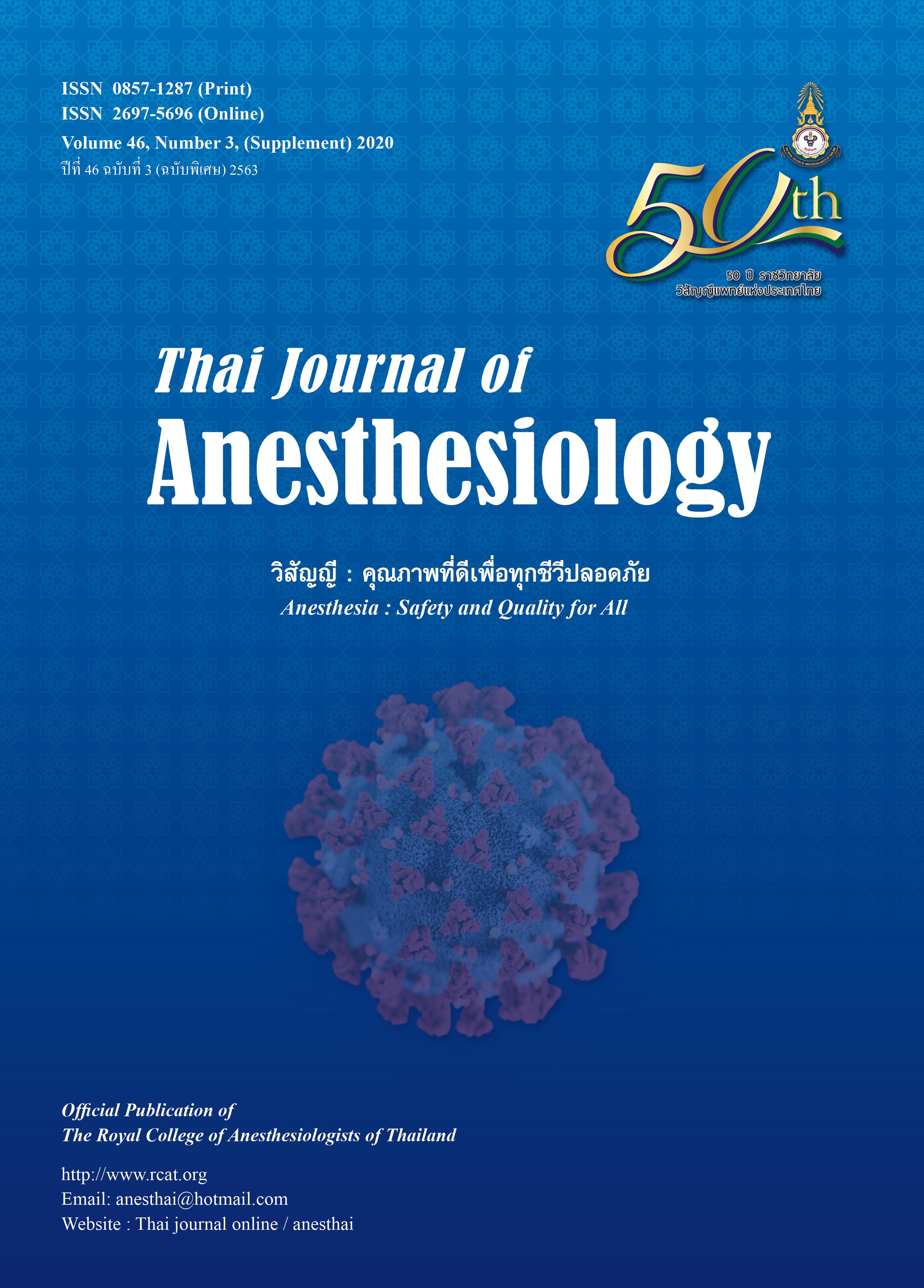Survey on Usage of Personal Protective Equipment in Known or Suspected COVID-19 Infected Patients during Anesthesia Practice in Early Pandemic 2020 in Thailand
Main Article Content
Abstract
Occupational safety and management including
workplace risk assessment are our goals of study in this
COVID-19 pandemic. The guidance on COVID-19 for Thai
anesthesiologists and perioperative care providers has
been announced by the Royal College of Anesthesiologists
of Thailand (RCAT) since March 15th, 2020. The Google
form survey was distributed to members by the RCAT
committees through Line and Facebook. There were 41
responses from 20 hospitals, comprising 40 patients, 11
of COVID-19 positive, 18 of patient under investigation
and 11 of emergency cases. Intubations were done in
airborne infection isolation negative pressure room 32.5%,
isolation operating room 17.5%, operating room 35%, ICU
2.5%, COVID ward 7.5%, emergency room 2.5% and the
ambulance car 2.5% . The varieties of personal protective
equipment usage depend on the hospital policies,
availability of the supply and their innovation. Head and
face were 100% covered. The disposable N95 mask,
coverall max protection, nitrile plus surgical glove and
leg-foot cover were used 70.7 %, 46.3%, 53.7% and 87.5%
respectively. Minimized exposure during intubation was
done by the alternative methods using acrylic box or plastic
shielded screening (37.5%), videolaryngoscope (82.8%),
rapid sequence induction (73.2%) and confirmed by
end-tidal capnograph (92.5%). Eventhough being
protected most providers still felt for their infection risk of
moderate risk (61.9%) to high risk (16.7%). Wearing the
Jupiter gown with powered air-purifying respirator made
them comfortable with no risk (21.4%).
Article Details
References
โรคติดเชื้อไวรัสโคโรนา 2019 ฉบับที่ 138 [Internet]. 20 พฤษภาคม
2563 [cited 2020 May 20]. Available from: https://ddc.moph.
go.th/viralpneumonia/file/situation/situation-no138-200563
new.pdf
2. World Federation of Societies of Anesthesiologist. COVID-19
guidance for anaesthesia and perioperative care providers
[Internet]. [cited 2020 april 9]. Available from: https://www.
wfsahq.org/images/Guidance_on_COVID-19_and_anaesthesia.
3. ราชวิทยาลัยวิสัญญีแพทย์แห่งประเทศไทย. ประกาศราชวิทยาลัย
วิสัญญีแพทย์แห่งประเทศไทยเรื่อง แนวทางปฏิบัติการดูแลผู้ป่วย
ที่ติดเชื้อหรือสงสัยว่าติดเชื้อไวรัส COVID-19 ที่มารับการระงับ
ความรู้สึก [Internet]. 15 มีนาคม 2563 [cited 2020 June 2].
Available from: http://www.anesthai.org/th/news/view/23
4. Anesthesia Patient Safety Foundation (APSF). The use of
personal protective equipment by anesthesia professionals
during the COVID-19 pandemic [Internet]. March 22, 2020
[cited 2020 March 22]. Available from: https://www.apsf.org/
news-updates/the-use-of-personal-protective-equipment-byanesthesia-
professionals-during-the-covid-19-pandemic/
5. ราชวิทยาลัยวิสัญญีแพทย์แห่งประเทศไทย. ประกาศราชวิทยาลัย
วิสัญญีแพทย์แห่งประเทศไทยเรื่อง แนวทางปฏิบัติการดูแลผู้ป่วย
ที่ติดเชื้อหรือสงสัยว่าติดเชื้อไวรัส COVID-19 ที่มารับการระงับ
ความรู้สึก[Internet]. 24 เมษายน 2563 [cited 2020 June 2].
Available from: http://www.anesthai.org/th/news/view/23


